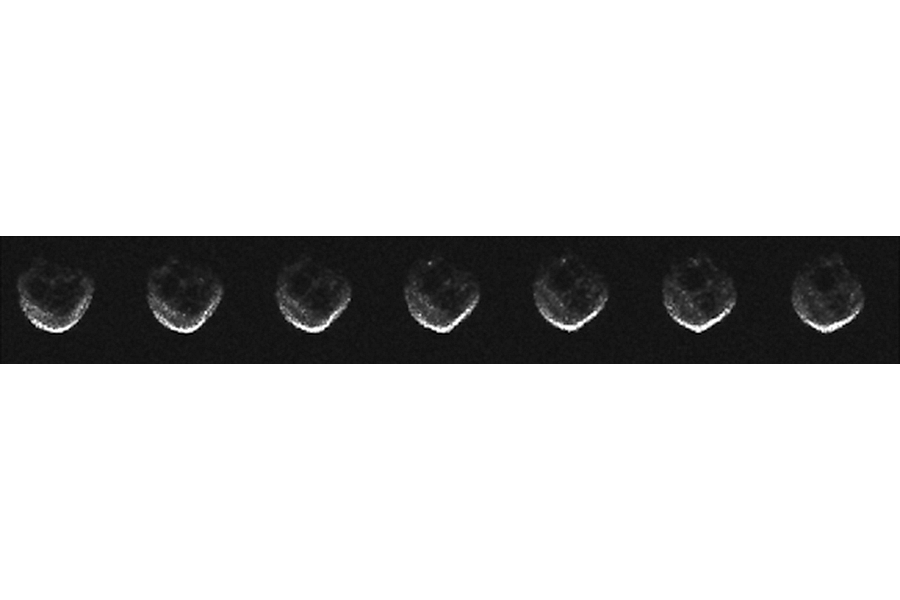That asteroid that flew by Earth on Halloween sort of looks like a skull
Loading...
On Halloween night, while ghouls and goblins did their trick-or-treating, an asteroid that is most likely a dead comet made a close flyby of Earth, with radar images revealing its eerie skull shape.
On Saturday (Oct. 31), the asteroid 2015 TB145 passed by Earth at a range of just over 300,000 miles (480,000 kilometers), placing it just outside the orbit of the moon, where it posed no threat to the planet. The timing of the flyby earned the asteroid - which is about 2,000 feet (600 meters) across - the nickname "Spooky" and "Great Pumpkin."
Unfortunately for skywatching hobbyists, 2015 TB145 was extremely difficult to see from the ground, but the online Slooh Community Observatory hosted a webcast Saturday afternoon that featured updates on the asteroid's path, and discussions about the dangers of near-Earth asteroids. [Related: Boo! Halloween Asteroid Looks Just Like a Skull]
NASA observed the asteroid with radar in infrared using its NASA Infrared Telescope Facility (IRTF) in Mauna Kea, Hawaii.
"The IRTF data may indicate that the object might be a dead comet, but in the Arecibo images it appears to have donned a skull costume for its Halloween flyby," Kelly Fast, IRTF program scientist and acting program manager for NASA's NEO Observations Program, said in a NASA statement Friday (Oct. 30).
Slooh used a remotely operated observatory in the Canary Islands to record animations of asteroid 2015 TB145 passing by. The "dead comet" asteroid looks like a bright object speeding across a starry background in those views. It was Slooh who nicknamed the asteroid "Spooky," and the online observatory was thrilled to see the space rock's skull shape in radar views.
"We all saw those dramatic images of the skull-like object whirling through space captured by NASA's Arecibo Observatory," Slooh's Tricia Ennis wrote in an email update. "We got a kick out of how appropriate our 'Spooky' moniker ended up being, here at Slooh."
The flyby was a treat for scientists, because it allowed them to see the space rock up close, with a radar resolution of as little as 6.6 feet (2 meters) on the surface. On Saturday, scientists fired radio waves at the passing space rock using a 110-foot-wide (34 m) antenna at NASA's Deep Space Network facility in Goldstone, California. The radio waves that bounced off the asteroid and came back to Earth were then collected using the Green Bank Telescope in West Virginia and Puerto Rico's Arecibo Observatory.
Radar images from those observations revealed asteroid 2015 TB145 true size (it's a bit larger than previously thought) and its speed. The asteroid is hurtling through space at a whopping 78,293 mph (126,000 km/h).
"This would generate a 6-mile-wide crater if it were to the Earth, something of this size and speed," asteroid impact expert Mark Boslough, a physicist at Sandia National Laboratories in New Mexico, said in the Slooh webcast. He was also impressed by the early radar images of the 2015 TB145.
"This is beautiful. It's such a high-resolution, nice image. You can see it rotating you can see features on the surface," Boslough said. "This is great science."
The speed of 2015 TBA145's flyby is considered high for an asteroid flyby, according to a statement from NASA's Jet Propulsion Laboratory (JPL). The Halloween asteroid may actually be a comet, but if that's the case it's a dead comet, meaning it no longer contains the volatile ingredients that sublimate in space and give comets their bright tails.
"We found that the object reflects about six percent of the light it receives from the sun," said Vishnu Reddy, a research scientist at the Planetary Science Institute, Tucson, Arizona, in the NASA statement. "That is similar to fresh asphalt, and while here on Earth we think that is pretty dark, it is brighter than a typical comet which reflects only 3 to 5 percent of the light. That suggests it could be cometary in origin - but as there is no coma evident, the conclusion is it is a dead comet."
In addition, its orbit is "very oblong with a high inclination to below the plane of the solar system," Lance Benner, who leads NASA's asteroid radar research program, said in an earlier JPL statement.
Benner said this would be the first time that the Goldstone facility has imaged a comet from such a close distance. Benner also called asteroid 2015 TB145 "one of the best asteroids for radar imaging we'll see for several years."
Asteroid 2015 TB145 was only discovered Oct. 10, less than a month from its closest approach to Earth. And by mapping its trajectory, scientist were able to confirm that it made a similarly close approach to Earth in 1975. The next large asteroid to make a close flyby of Earth (that scientists know of) won't take place until 2027.
Follow us @Spacedotcom, Facebook and Google+. Original article on Space.com.
- Trick Or Treat? Halloween Asteroid Is ‘Sears Tower-Sized’ | Orbit Animation
- Potentially Dangerous Asteroids (Images)
- Asteroid Basics: A Space Rock Quiz
Copyright 2015 SPACE.com, a Purch company. All rights reserved. This material may not be published, broadcast, rewritten or redistributed.







